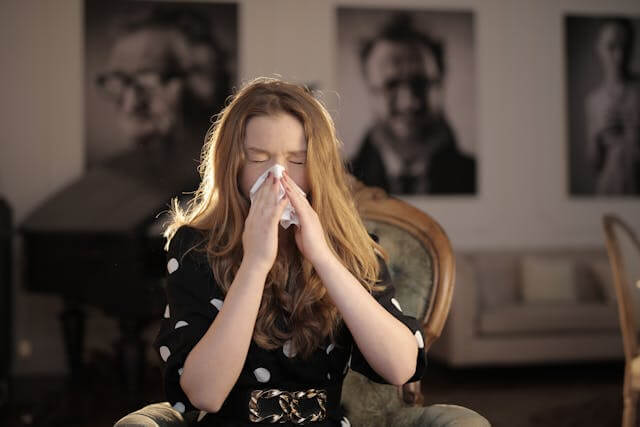As the vibrant colors of fall begin to paint the landscape, many look forward to cooler weather and seasonal festivities. However, for migraine sufferers, autumn can bring more than just cozy sweaters and pumpkin spice lattes—it can also usher in a new set of migraine triggers, particularly in the form of fall allergies.
The Connection Between Allergies and Migraines
Allergies, or allergic rhinitis, occur when your immune system overreacts to environmental substances such as pollen, mold, or dust mites. During fall, common allergens like ragweed, outdoor mold, and leaf debris are prevalent. For many, these allergens trigger sneezing, itchy eyes, and congestion. However, for individuals prone to migraines, allergies can also be a potent headache trigger.

Research suggests that people with migraines are more likely to experience headaches when they are exposed to allergens. The inflammatory response caused by allergies can result in sinus pressure, leading to what some people think of as a “sinus headache.” However, in many cases, these headaches may actually be migraines, as both share similar symptoms, such as throbbing pain, nasal congestion, and sensitivity to light.
Why Fall Allergens Trigger Migraines
The exact mechanisms linking allergies to migraines are still being studied, but there are several potential explanations:
Sinus Pressure and Inflammation: When allergens trigger an immune response, it can lead to inflammation in the nasal passages and sinuses. This inflammation increases sinus pressure, which can trigger or exacerbate migraine attacks.
Histamine Release: During an allergic reaction, the body releases histamine, a compound that plays a role in immune responses. Histamine dilates blood vessels, which can contribute to the vascular changes seen in migraines.
Cytokine Production: Allergies can cause the release of pro-inflammatory cytokines, chemicals involved in the body’s immune response. These chemicals can heighten sensitivity to pain and trigger migraine episodes.
Environmental Changes: The transition to fall brings with it changes in weather, barometric pressure, and humidity—all of which are known migraine triggers. Combined with allergy exposure, this makes fall a particularly challenging season for many migraine sufferers.
Common Fall Allergens That Trigger Migraines
If you’re experiencing more migraines during the autumn months, these fall allergens might be to blame:
Ragweed Pollen: Ragweed is one of the most common triggers of fall allergies, releasing pollen from late August through November. Even if you don’t live near ragweed, the wind can carry pollen for hundreds of miles, making it hard to escape.
Mold Spores: As leaves fall and decay, mold can form in leaf piles, releasing spores into the air. Indoor mold, often caused by dampness from rain, can also trigger allergic reactions.
Dust Mites: With cooler temperatures, people tend to spend more time indoors. This means greater exposure to indoor allergens like dust mites, which thrive in bedding, carpets, and upholstered furniture.
How to Manage Fall Allergies and Reduce Migraine Triggers
Fortunately, there are several steps you can take to manage fall allergies and, in turn, reduce your risk of migraines.
1. Limit Outdoor Exposure
On days when pollen counts are high, try to stay indoors, especially during peak pollen times, usually early morning. Keep windows closed to prevent allergens from entering your home. If you spend time outside, change clothes and shower to remove allergens from your skin and hair. Windy days can also kick up the dust, so beware.

Keep your windows closed
2. Use an Air Purifier
Investing in a high-efficiency particulate air (HEPA) filter can help reduce the amount of airborne allergens in your home. Regularly vacuum your living spaces and consider using allergy-proof covers on mattresses and pillows to reduce dust mite exposure.
3. Try a Nasal Rinse
Using a saline nasal spray or rinse can help flush out allergens from your nasal passages and reduce sinus inflammation, lowering the chances of a migraine being triggered by sinus pressure.
4. Take Preventative Medications
If you know you’re prone to fall allergies, taking antihistamines or using prescribed or over-the-counter nasal sprays can help control allergic reactions before they trigger a migraine. However, be cautious with overuse of decongestants, as they can sometimes worsen headaches.
5. Stay Hydrated
Fall weather can be deceiving—cooler temperatures might make you feel less thirsty, but staying hydrated is essential for preventing both allergic reactions and migraines. Dehydration is a known migraine trigger, and it can worsen the effects of allergens.
6. Consider Natural Supplements
Some nutritional supplements such as MigreLief are designed to help maintain healthy neurological function and comfort.
When to See a Doctor
If your migraines are worsening during the fall allergy season and over-the-counter treatments aren’t helping, it may be time to see a healthcare provider. They can offer guidance on allergy testing, prescribe stronger allergy medications, or recommend a migraine-specific treatment plan.
Final Thoughts
While fall may be a beautiful season, it can also be a challenging time for migraine sufferers who deal with allergies. Understanding the connection between allergies and migraines can help you take the necessary steps to minimize your exposure to allergens and prevent headaches before they start.
Be proactive with your health so you can enjoy the best of what fall has to offer unburdened.


